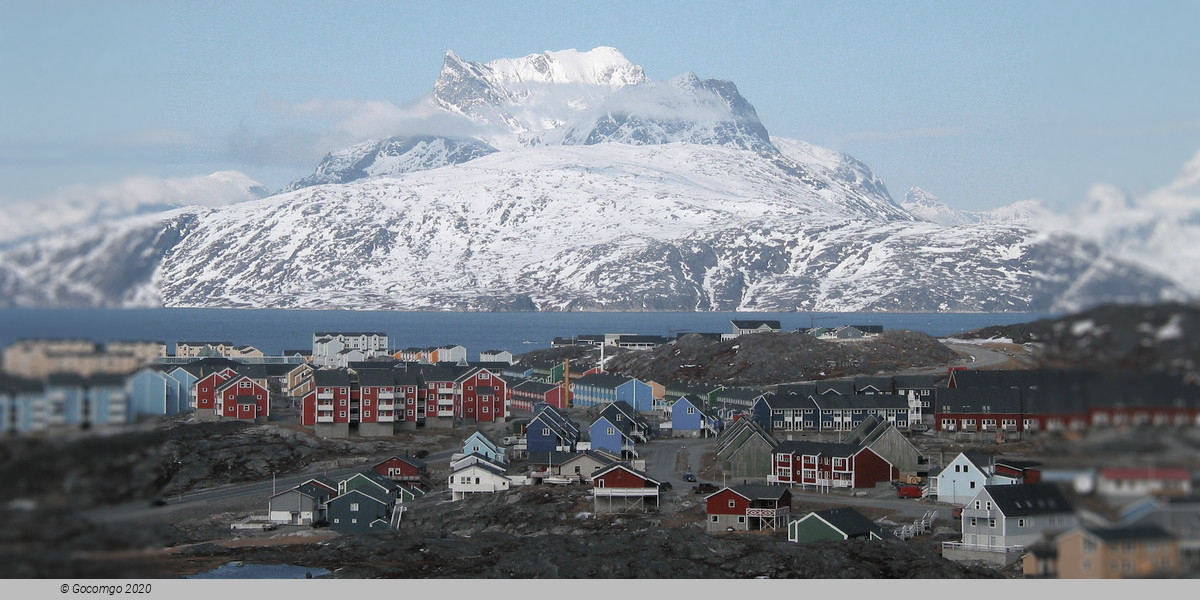Nuuk

Nuuk is the capital and largest city of Greenland. Nuuk is the seat of government and the country's largest cultural and economic center. The major cities from other countries closest to the capital are Iqaluit and St. John's in Canada and Reykjavík in Iceland. Nuuk contains almost a third of Greenland's population and its tallest building. Nuuk is also the seat of government for the Sermersooq municipality. The city was founded in 1728 by the Dano-Norwegian governor Claus Paarss when he relocated Hans Egede's earlier Hope Colony to the mainland and was named Godthåb ("Good Hope").
History
The site has a long history of habitation. The area around Nuuk was first occupied by the ancient, pre-Inuit, Paleo-Eskimo people of the Saqqaq culture as far back as 2200 BC when they lived in the area around the now abandoned settlement of Qoornoq. For a long time, it was occupied by the Dorset culture around the former settlement of Kangeq but they disappeared from the Nuuk district before AD 1000. The Nuuk area was later inhabited by Viking explorers in the 10th century (Western Settlement), and shortly thereafter by Inuit peoples. Inuit and Norsemen both lived with little interaction in this area from about 1000 until the disappearance of the Norse settlement for uncertain reasons during the 15th century.
The city proper was founded as the fort of Godt-Haab in 1728 by the royal governor Claus Paarss, when he relocated the missionary and merchant Hans Egede's earlier Hope Colony (Haabets Koloni) from Kangeq Island to the mainland. At that time, Greenland was formally still a Norwegian colony (until 1814) under the united Dano-Norwegian Crown, but the colony had not had any contact for over three centuries. Paarss's colonists consisted of mutinous soldiers, convicts, and prostitutes and most died within the first year of scurvy and other ailments. In 1733 and 1734, a smallpox epidemic killed most of the native population as well as Egede's wife. Hans Egede went back to Denmark in 1736 after 15 years in Greenland, leaving his son Poul to continue his work. Godthaab became the seat of government for the Danish colony of South Greenland, while Godhavn (modern Qeqertarsuaq) was the capital of North Greenland until 1940 when the administration was unified in Godthaab.
In 1733, Moravian missionaries received permission to begin a mission on the island; in 1747, there were enough converts to prompt the construction of the Moravian Brethren Mission House and the formal establishment of the mission as New Herrnhut. This became the nucleus for present-day Nuuk as many Greenlanders from the southeastern coast left their territory to live at the mission station. From this base, further missions were established at Lichtenfels (1748), Lichtenau (1774), Friedrichsthal (1824), Umanak (1861), and Idlorpait (1864), before they were discontinued in 1900 and folded into the Lutheran Church of Denmark.
Around 1850, Greenland, and especially the area around Nuuk, were in crisis. The Europeans had brought diseases and a culture that conflicted with the ways of the native Greenlanders. Many Greenlanders were living in poverty. In 1853, Hinrich Johannes Rink came to Greenland and perceived the Greenlanders had lost much of their culture and identity under Danish influence. In response, in 1861, he started the Atuagagdliutt, Greenland's first newspaper, with a native Greenlander as editor. This newspaper based in Nuuk later became significant for the Greenlandic identity.
During World War II, there was a reawakening of Greenlandic national identity. Greenlanders shared a written language and assembled a council under Eske Brun's leadership in Nuuk. In 1940, an American and a Canadian Consulate were established in Nuuk. Under new regulations in 1950, two councils amalgamated into one. This Countryside Council was abolished on 1 May 1979, when the city of Godthåb was renamed Nuuk by the Greenland Home Rule government. The city boomed during the 1950s when Denmark began to modernize Greenland. As in Greenland as a whole, Nuuk is populated today by both Inuit and Danes. Over a third of Greenland's total population lives in the Nuuk Greater Metropolitan area.

